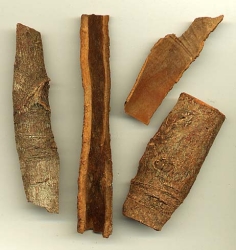 Cinnamomum
cassia. C aromaticum, C. lignea Chinese
Cinnamon,
Cassia Bark, Bastard Cinnamon, False Cinnamon
Family: Lauraceae
Cinnamomum
cassia. C aromaticum, C. lignea Chinese
Cinnamon,
Cassia Bark, Bastard Cinnamon, False Cinnamon
Family: Lauraceae
 Cinnamomum
cassia. C aromaticum, C. lignea Chinese
Cinnamon,
Cassia Bark, Bastard Cinnamon, False Cinnamon
Family: Lauraceae
Cinnamomum
cassia. C aromaticum, C. lignea Chinese
Cinnamon,
Cassia Bark, Bastard Cinnamon, False Cinnamon
Family: Lauraceae
PART USED:
Bark The cultivated
trees are kept as coppices, the shoots are not allowed to grow more than 3 m.
The trees are at their best at 10-12 years of age. The bark is cut from
the young shoots when the leaves are red.
The bark is brown, in quilled pieces, sometimes with the remains of the outer
layer present.
TASTE and ODOR: Similar to cinnamon but distinct.
ACTIONS
1. Carminative.[1]
2. Spasmolytic.[1]
3. Stomachic.[2] Sstrengthens
gastric secretions.
4. Aromatic.[2]
5. Anti-emetic.[1] Antidiarrheal.[1]
Antimicrobial.[1] Mildly astringent.
6. Tonic.[2]
7. Antipyretic.[2]
8. Diaphoretic.[2]
9. Analgesic.[2]
10. Emmenagogue. Capable of decreasing secretion of milk.
11. Antidiabetic- Modulates insulin sensitivity in Type 2 diabetes. Reduces
inflammatory markers in metabolic syndrome. Stimulates uptake of glucose via
stimulation of GLUT4 protein (primary glucose transporter in muscle, cardiac,
and fat cells).[4]
INDICATIONS - useful as a flavoring.
1. Diarrhea.[1]Flatulent
dyspepsia.[1] Nausea. Flatulent
colic.[1] Vomiting. Flatulent
Distension.
2. Common cold.[1]
SPECIFIC INDICATIONS: Colic or dyspepsia with flatulent distension
and nausea.[1]
COMBINATIONS
- Flatulent dyspepsia, and gastritis, use with Meadowsweet,
Chamomile, and Marshmallow
Root.
- Diarrhea with tormina (griping pains), use with Geranium,
Oak and Catechu.
- Common cold, use with Millefolium,
Peppermint and Sambucus.
COMPARISONS
The bark is thicker, coarser, darker and duller, the flavor more pungent, less
sweet and delicate, and slightly bitter than Cinnamomum zeylanicum= Ceylon Cinnamon. The
stronger flavor is preferred by German and Roman chocolate makers. The volatile
oil is cheaper and more abundant than oil of Ceylon Cinnamon, so Materia
Medicas usually are referring to C. cassia.
PREPARATIONS 3X /day
Dried bark 0.5-1g,[1]
or by infusion 1:20.
Tincture (BHP1949) 2-4ml.[1]

 PART
USED: Volatile
Oil - Internal or external use is not recomended due to its
concentrated and irritant nature. Mainly used for flavouring medicines,
cosmetics, toothpastes, mouthwashes and foods.
PART
USED: Volatile
Oil - Internal or external use is not recomended due to its
concentrated and irritant nature. Mainly used for flavouring medicines,
cosmetics, toothpastes, mouthwashes and foods.
Cinnamon use in type 2 diabetes: an updated systematic review and meta-analysis.
Allen RW, Schwartzman E, Baker WL, Coleman CI, Phung OJ.
Abstract
PURPOSE:
Cinnamon has been studied in randomized controlled trials (RCTs) for its glycemic-lowering
effects, but studies have been small and show conflicting results. A prior meta-analysis
did not show significant results, but several RCTs have been published since
then. We conducted an updated systematic review and meta-analysis of RCTs evaluating
cinnamon's effect on glycemia and lipid levels.
METHODS:
MEDLINE, Embase, and Cochrane Central Register of Controlled
Trials (CENTRAL) were searched through February 2012. Included RCTs evaluated
cinnamon compared with control in patients with type 2 diabetes and reported
at least one of the following: glycated hemoglobin (A1c), fasting plasma glucose,
total cholesterol, low-density lipoprotein cholesterol (LDL-C), high-density
lipoprotein cholesterol (HDL-C), or triglycerides. Weighted mean differences
(with 95% confidence intervals) for endpoints were calculated using random-effects
models.
RESULTS:
In a meta-analysis of 10 RCTs (n = 543 patients), cinnamon doses of 120 mg/d
to 6 g/d for 4 to 18 weeks reduced levels of fasting plasma glucose (-24.59
mg/dL; 95% CI, -40.52 to -8.67 mg/dL), total cholesterol (-15.60 mg/dL; 95%
CI, -29.76 to -1.44 mg/dL), LDL-C (-9.42 mg/dL; 95% CI, -17.21 to -1.63 mg/dL),
and triglycerides (-29.59 mg/dL; 95% CI, -48.27 to -10.91 mg/dL). Cinnamon also
increased levels of HDL-C (1.66 mg/dL; 95% CI, 1.09 to 2.24 mg/dL). No significant
effect on hemoglobin A1c levels (-0.16%; 95%, CI -0.39% to 0.02%) was seen.
High degrees of heterogeneity were present for all analyses except HDL-C (I(2)
ranging from 66.5% to 94.72%).
CONCLUSIONS:
The consumption of cinnamon is associated with a statistically significant decrease
in levels of fasting plasma glucose, total cholesterol, LDL-C, and triglyceride
levels, and an increase in HDL-C levels; however, no significant effect on hemoglobin
A1c was found. The high degree of heterogeneity may limit the ability to apply
these results to patient care, because the preferred dose and duration of therapy
are unclear. Ann Fam Med. 2013 Sep-Oct;11(5):452-9. doi: 10.1370/afm.1517. ncbi.nlm.nih.gov
Antidiabetic effect of Cinnamomum cassia and Cinnamomum zeylanicum in
vivo and in vitro.
Verspohl EJ, Bauer K, Neddermann E.
Abstract
Rats were given Cinnamomum cassia bark or extracts from Cinnamomum cassia and
zeylanicum to evaluate blood glucose and plasma insulin levels in rats under
various conditions. The cassia extract was superior to the zeylanicum extract.
The cassia extract was slightly more efficacious than the equivalent amount
of Cassia bark. A decrease in blood glucose levels was observed in a glucose
tolerance test (GTT), whereas it was not obvious in rats that were not challenged
by a glucose load. The elevation in plasma insulin was direct since a stimulatory
in vitro effect of insulin release from INS-1 cells (an insulin secreting cell
line) was observed. Thus the cassia extract has a direct antidiabetic potency.
PMID: 15934022 DOI: 10.1002/ptr.1643 Phytother Res. 2005 Mar;19(3):203-6. ncbi.nlm.nih.gov